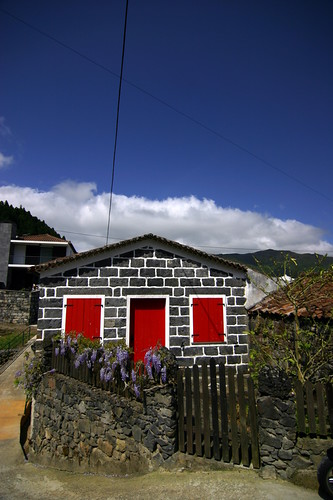Feminine hands embroider linen with traditional motifs in which blue and green flowers predominate. They also make dainty lace, artificial flowers and the typical caps worn by shepherds. The men, on the other hand, account for the wickerwork, pottery, objects of daily use made from the island's cedarwood, ornaments made from animal horns, tin articles, colourful slippers, practical galoshes and the guitars that are heard on feast days.
The counterpanes made on looms
The weaving tradition on Terceira dates back to the settlement period, when families depended on home-made woollen and linen cloth to make their own clothing.
The heavy old looms are still used to make woollen counterpanes in many colours and with geometrical designs. These counterpanes are used all over the island to cover beds and also to decorate windows on festive occasions.
The "empires" of the Holy Ghost
The colourful chapels known as impérios (empires) or teatros (theatres) of the Holy Ghost, with their showy decorations and fantastic shapes, contrast with the whiteness of the villages of Terceira and are one of the most consummate and interesting forms of Azorean popular architecture and of the peculiarities of the local way of fife and feelings.
Spread all over the island - where there are over fifty of them - most of these impérios date from the 19th century, when they replaced the original ones, part of which, it is supposed, were wooden affairs that could be put together and taken apart. Annexed to the "empires" are the "larders", where the bread, meat and wine to be used in the festivals is kept; some of them have allegorical decorations.
At the top of their facades the "empires" have a white dove or crown. The windows are large, usually with wrought iron gratings. Inside are the altar, with the niche where the crown and plate are placed, and the tables used by the members of the Brotherhood to receive alms and to offer food and wine to anyone they want to.
The houses with their curious chimneys
The fact that most of the settlers of Terceira came from the Alentejo and Algarve in southern Portugal is revealed by the rural houses, with their white walls and coloured edgings along the doors, windows and corners. Made up of dressed stones forming a rectangular parallelepiped which ends in a wedge, the chimneys are called mão-postas by the people. To prevent rain from entering, many have a terminal part made of bricks or tiles. Typical, too, are the "aprons" of dressed stone; rounded or of straight lines, they come down from the window sill and end in a fleur-de-lis, point or rosette.
Every house in Terceira has a surrounding garden and next to it is the burra de milho where the ears of maize are kept when they are not simply hung from the branches of trees, which offers a unique and unexpected sight.
The counterpanes made on looms
The weaving tradition on Terceira dates back to the settlement period, when families depended on home-made woollen and linen cloth to make their own clothing.
The heavy old looms are still used to make woollen counterpanes in many colours and with geometrical designs. These counterpanes are used all over the island to cover beds and also to decorate windows on festive occasions.
The "empires" of the Holy Ghost
The colourful chapels known as impérios (empires) or teatros (theatres) of the Holy Ghost, with their showy decorations and fantastic shapes, contrast with the whiteness of the villages of Terceira and are one of the most consummate and interesting forms of Azorean popular architecture and of the peculiarities of the local way of fife and feelings.
Spread all over the island - where there are over fifty of them - most of these impérios date from the 19th century, when they replaced the original ones, part of which, it is supposed, were wooden affairs that could be put together and taken apart. Annexed to the "empires" are the "larders", where the bread, meat and wine to be used in the festivals is kept; some of them have allegorical decorations.
At the top of their facades the "empires" have a white dove or crown. The windows are large, usually with wrought iron gratings. Inside are the altar, with the niche where the crown and plate are placed, and the tables used by the members of the Brotherhood to receive alms and to offer food and wine to anyone they want to.
The houses with their curious chimneys
The fact that most of the settlers of Terceira came from the Alentejo and Algarve in southern Portugal is revealed by the rural houses, with their white walls and coloured edgings along the doors, windows and corners. Made up of dressed stones forming a rectangular parallelepiped which ends in a wedge, the chimneys are called mão-postas by the people. To prevent rain from entering, many have a terminal part made of bricks or tiles. Typical, too, are the "aprons" of dressed stone; rounded or of straight lines, they come down from the window sill and end in a fleur-de-lis, point or rosette.
Every house in Terceira has a surrounding garden and next to it is the burra de milho where the ears of maize are kept when they are not simply hung from the branches of trees, which offers a unique and unexpected sight.



No comments:
Post a Comment